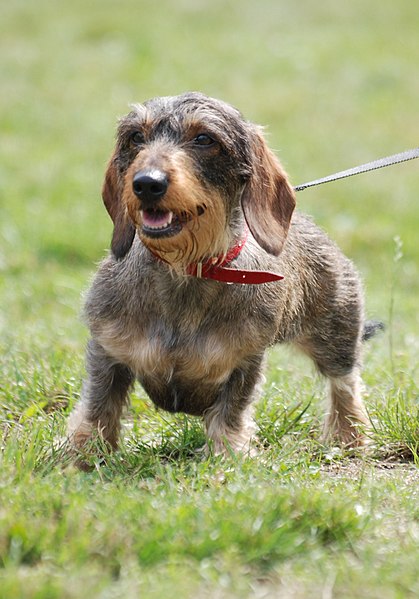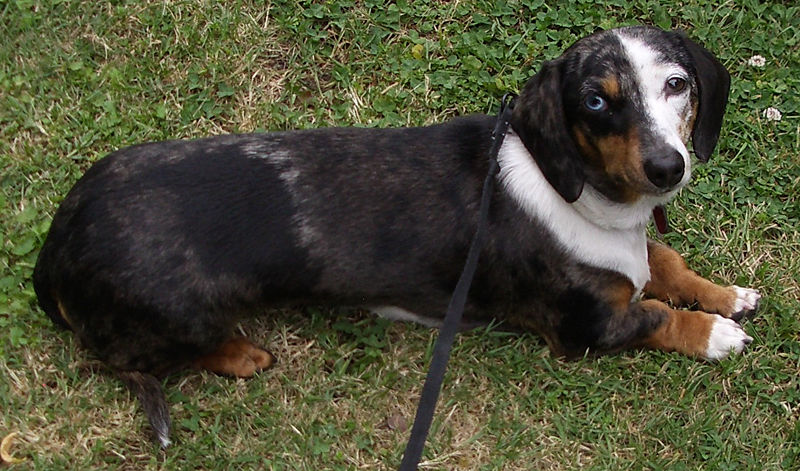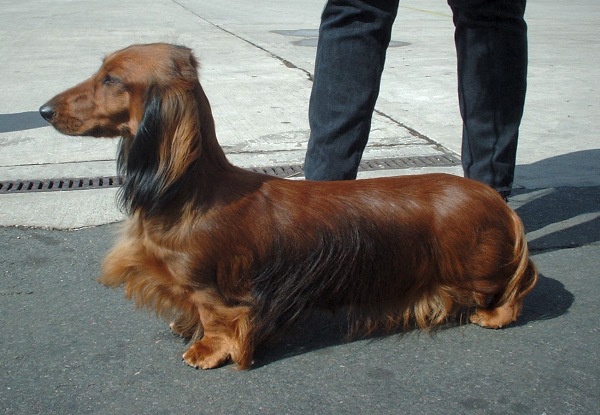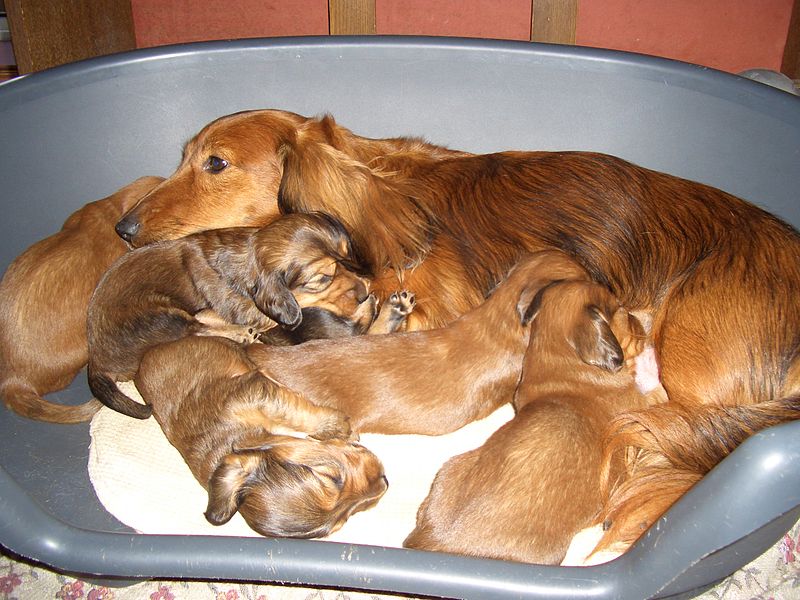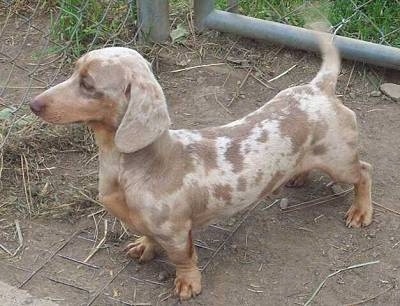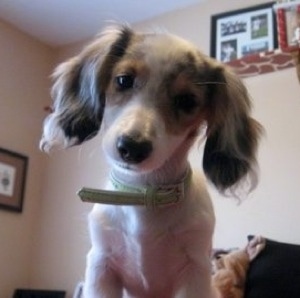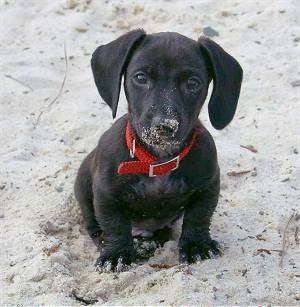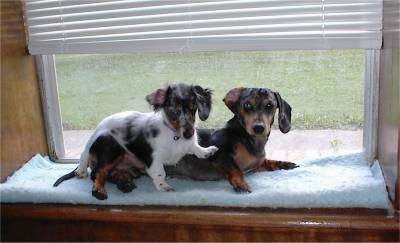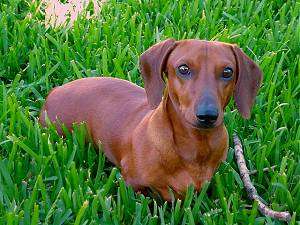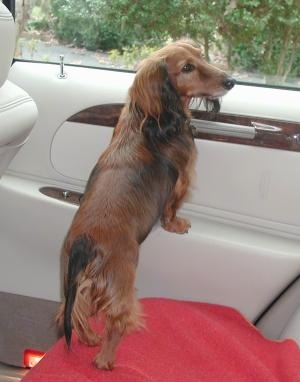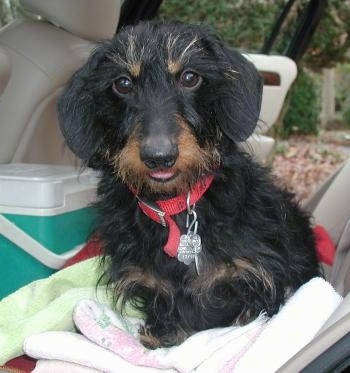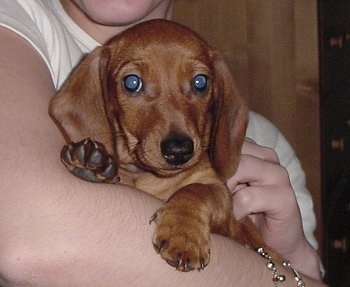The dachshund is a short-legged, elongated dog breed, of the hound family. The standard size was developed to scent, chase, and flush badgers and other burrow-dwelling animals, while the miniature was developed to hunt smaller prey, like rabbits. In the American West, they have also been used to hunt prairie dogs.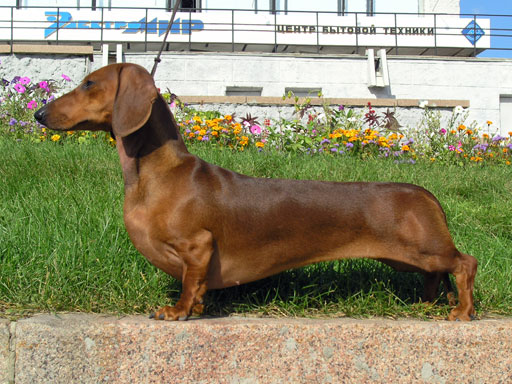
The name "dachshund" is of German origin and literally means "badger dog", from Dachs ("badger") and Hund ("dog"). The pronunciation varies widely in English: variations of the first syllable include /ˈdɑːks/, /ˈdæks/ and /ˈdæʃ/, and of the second syllable /hʊnt/, /hʊnd/ and /ənd/.

The name "dachshund" is of German origin and literally means "badger dog", from Dachs ("badger") and Hund ("dog"). The pronunciation varies widely in English: variations of the first syllable include /ˈdɑːks/, /ˈdæks/ and /ˈdæʃ/, and of the second syllable /hʊnt/, /hʊnd/ and /ənd/.
In German it is pronounced [ˈdakshʊnt]. Because of their long, narrow build, they are sometimes nicknamed hot dog dog, wiener dog or sausage dog. Although "dachshund" is a German word, in modern German they are also commonly known by the name Dackel; in the case of the formally certified hunting and tracking rank, the name Teckel is used.
While classified in the hound group or scent hound group in the United States and Great Britain, there are some who consider this classification to be arguable, speculating that it arose from the fact that the word Hund is similar to the English word hound - and the word "Dachshund" has even been both pronounced and translated, albeit incorrectly, as "Dash Hound". Many dachshunds, especially the wire-haired subtype, may exhibit behavior and appearance that are similar to that of the terrier group of dogs.
While classified in the hound group or scent hound group in the United States and Great Britain, there are some who consider this classification to be arguable, speculating that it arose from the fact that the word Hund is similar to the English word hound - and the word "Dachshund" has even been both pronounced and translated, albeit incorrectly, as "Dash Hound". Many dachshunds, especially the wire-haired subtype, may exhibit behavior and appearance that are similar to that of the terrier group of dogs.
An argument can be made for the scent (or hound) group classification because the breed was developed to utilize scent to trail and hunt animals, and probably descended from scent hounds, such as bloodhounds, pointers, Basset Hounds, or even Bruno Jura Hounds; but with the dogged and persistent personality and love for digging that probably developed from the terrier, it can also be argued that they could belong in the terrier, or "earth dog", group. In the Fédération Cynologique Internationale (World Canine Federation), or FCI, the dachshund is actually in its own group, Group 4, which is the dachshund group. Part of the controversy is due to the fact that the dachshund is the only certifiable breed of dog to hunt both above and below ground.
Characteristics
Appearance
The typical dachshund is long-bodied and muscular, with short and stubby legs. Its paws are unusually large and paddle-shaped, for efficient digging. It has skin that is loose enough not to tear while tunnelling in tight burrows to chase prey. The dachshund has a deep chest to allow enough lung capacity to keep going when hunting. Its snout is long with an increased nose area that absorbs odours.
There are three types, classified by their coats: short-haired, called "smooth"; long-haired; and wire-haired.
There are three types, classified by their coats: short-haired, called "smooth"; long-haired; and wire-haired.
Size
Dachshunds come in three sizes: standard, miniature, and kaninchen, which means rabbit. Although the standard and miniature sizes are recognized almost universally, the rabbit size is not recognized by clubs in the United States and the United Kingdom, but is recognized by all of the clubs within the Fédération Cynologique Internationale (World Canine Federation) (FCI), which contain kennel clubs from 83 countries all over the world.
A full-grown standard dachshund averages 15 lb (6.8 kg) to 28 lb (13 kg), while the miniature variety normally weighs less than 11 lb (5.0 kg). The kaninchen weighs 8 lb (3.6 kg) to 10 lb (4.5 kg). According to kennel club standards, the miniature (and kaninchen, where recognized) differs from the full-size only by size and weight, thus offspring from miniature parents must never weigh more than the miniature standard to be considered a miniature as well. While many kennel club size divisions use weight for classification, such as the American Kennel Club, other kennel club standards determine the difference between the miniature and standard by chest circumference; some kennel clubs, such as in Germany, even measure chest circumference in addition to height and weight.
H. L. Mencken said that "A dachshund is a half-dog high and a dog-and-a-half long," although they have been referred to as "two dogs long". This characteristic has led them to be quite a recognizable breed, and they are featured in many a joke and cartoon, particularly The Far Side by Gary Larson.
Coat and color
H. L. Mencken said that "A dachshund is a half-dog high and a dog-and-a-half long," although they have been referred to as "two dogs long". This characteristic has led them to be quite a recognizable breed, and they are featured in many a joke and cartoon, particularly The Far Side by Gary Larson.
Coat and color
Dachshunds exhibit three coat varieties: smooth coat (short hair), long hair, and wire-hair. Wirehaired is the least commonly seen coat in the US (it is the most common in Germany) and the most recent coat to appear in breeding standards.
Dachshunds have a wide variety of colors and patterns. They can be single-colored, single colored with spots ("dappled"-called "merle" in other dog breeds), and single-colored with tan points plus any pattern. Dachshunds also come in Piebald. The piebald has a white background with various shades of brown. The dominant color is red, the most common along with black and tan. Two-colored dogs can be black, wild boar, chocolate, or fawn ("Isabella") with tan "points", or markings over the eyes, ears, paws, and tail, of tan or cream. A two-colored dachshund would be called by its dominant color first followed by the point color, such as "black and tan" or "chocolate and cream". Other patterns include piebald, in which a white pattern is imposed upon the base color or any other pattern, and a lighter "boar" red. The reds range from coppers to deep rusts, with or without somewhat common black hairs peppered along the back, tail, face, and ear edges, lending much character and an almost burnished appearance;
Dachshunds have a wide variety of colors and patterns. They can be single-colored, single colored with spots ("dappled"-called "merle" in other dog breeds), and single-colored with tan points plus any pattern. Dachshunds also come in Piebald. The piebald has a white background with various shades of brown. The dominant color is red, the most common along with black and tan. Two-colored dogs can be black, wild boar, chocolate, or fawn ("Isabella") with tan "points", or markings over the eyes, ears, paws, and tail, of tan or cream. A two-colored dachshund would be called by its dominant color first followed by the point color, such as "black and tan" or "chocolate and cream". Other patterns include piebald, in which a white pattern is imposed upon the base color or any other pattern, and a lighter "boar" red. The reds range from coppers to deep rusts, with or without somewhat common black hairs peppered along the back, tail, face, and ear edges, lending much character and an almost burnished appearance;
this is referred to among breeders and enthusiasts as a "stag" or an "overlay" or "sable". True sable is a dachshund with each single hair banded with three colors: light at the base of the hair, red in the middle, black at the end. An additional, striking coat marking is the brindle pattern. "Brindle" refers to dark stripes over a solid background, usually red; if a dachshund is brindled on a dark coat and has tan points, you will see brindling on the tan points only. Even one single, lone stripe of brindle is brindle. If a dachshund has one single spot of dapple, it is a dapple.
Solid black and solid chocolate dachshunds occur and, even though dogs with such coloration are often considered handsome, the colors are nonstandard, that is, the dogs are frowned upon in the conformation ring in the US and Canada. Chocolate is commonly confused with dilute red. Additionally, according to the conformation judges of the Dachshund Club of America (DCA) and the American Kennel Club (AKC) the piebald pattern is nonstandard. However, The Piebald dachshund can still be shown, the only disqualifying Fault in Dachshunds is Knuckling over. While some judges choose to dismiss a dog of color, many choose to judge them and those who are actually judging the dog will look past the cosmetic color of a dog and judge the conformation of the dog first.
Solid black and solid chocolate dachshunds occur and, even though dogs with such coloration are often considered handsome, the colors are nonstandard, that is, the dogs are frowned upon in the conformation ring in the US and Canada. Chocolate is commonly confused with dilute red. Additionally, according to the conformation judges of the Dachshund Club of America (DCA) and the American Kennel Club (AKC) the piebald pattern is nonstandard. However, The Piebald dachshund can still be shown, the only disqualifying Fault in Dachshunds is Knuckling over. While some judges choose to dismiss a dog of color, many choose to judge them and those who are actually judging the dog will look past the cosmetic color of a dog and judge the conformation of the dog first.
There were several Piebald dachshunds that became AKC Champions in 2008. All things being equal between the dogs in the ring, the traditional colors which are listed in the Official AKC Standard (governed by DCA) should be visibly listed.
Light-colored dachshunds can sport amber, light brown, or green eyes; however, kennel club standards state that the darker the eye color, the better. They can also have eyes of two different colors; however, this is only found in dapple and double dapple dachshunds. Dachshunds can have a blue and a brown eye. Blue eyes, partially blue eyes, or a blue eye and a brown eye are called "wall" coloring, and are considered a non-desirable trait in kennel club standards. Dappled eyes are also possible. The standard was changed by the DCA in 2007 to exclude the wording double-dapple from the standard and strictly use the wording dapple. The reason is that the double merle gene is linked to blindness and deafness. Wall-eye is permissible. Piebald-patterned dachshunds will never have blue in their eyes, unless the dapple pattern is present.
Light-colored dachshunds can sport amber, light brown, or green eyes; however, kennel club standards state that the darker the eye color, the better. They can also have eyes of two different colors; however, this is only found in dapple and double dapple dachshunds. Dachshunds can have a blue and a brown eye. Blue eyes, partially blue eyes, or a blue eye and a brown eye are called "wall" coloring, and are considered a non-desirable trait in kennel club standards. Dappled eyes are also possible. The standard was changed by the DCA in 2007 to exclude the wording double-dapple from the standard and strictly use the wording dapple. The reason is that the double merle gene is linked to blindness and deafness. Wall-eye is permissible. Piebald-patterned dachshunds will never have blue in their eyes, unless the dapple pattern is present.
Temperament
Dachshunds are playful, known for their propensity for chasing small animals, birds, and tennis balls with great determination and ferocity. Many dachshunds are stubborn, making them a challenge to train. Several quotes have been recorded regarding the training of dachshunds; one is from E. B. White:
"Being the owner of dachshunds, to me a book on dog discipline becomes a volume of inspired humor. Every sentence is a riot. Some day, if I ever get a chance, I shall write a book, or warning, on the character and temperament of the dachshund and why he can't be trained and shouldn't be. I would rather train a striped zebra to balance an Indian club than induce a dachshund to heed my slightest command. When I address Fred I never have to raise either my voice or my hopes. He even disobeys me when I instruct him in something he wants to do."
"Being the owner of dachshunds, to me a book on dog discipline becomes a volume of inspired humor. Every sentence is a riot. Some day, if I ever get a chance, I shall write a book, or warning, on the character and temperament of the dachshund and why he can't be trained and shouldn't be. I would rather train a striped zebra to balance an Indian club than induce a dachshund to heed my slightest command. When I address Fred I never have to raise either my voice or my hopes. He even disobeys me when I instruct him in something he wants to do."
They have a loud bark and without proper training they can become nuisance barkers. Dachshunds are known for their devotion and loyalty to their owners, though they can be standoffish towards strangers. If left alone, many dachshunds will whine until they have companionship. Like many dogs if left alone too frequently, some dachshunds are prone to separation anxiety and may chew objects in the house to relieve stress. They rank 49th in Stanley Coren's Intelligence of Dogs, being of average working and obedience intelligence. The dachshund will, in some cases, show above-average intelligence, being able to break out of improperly made cages or figuring out how to get their favorite blanket out of a basket.
Dachshunds can be difficult to housebreak, and patience and consistency is often needed in this endeavor.
According to the American Kennel Club’s breed standards, "the dachshund is clever, lively and courageous to the point of rashness, persevering in above and below ground work, with all the senses well-developed. Any display of shyness is a serious fault."Their temperament and body language give the impression that they do not know or care about their relatively small size.
Dachshunds can be difficult to housebreak, and patience and consistency is often needed in this endeavor.
According to the American Kennel Club’s breed standards, "the dachshund is clever, lively and courageous to the point of rashness, persevering in above and below ground work, with all the senses well-developed. Any display of shyness is a serious fault."Their temperament and body language give the impression that they do not know or care about their relatively small size.
Like many small hunting dogs, they will challenge a larger dog. Indulged dachshunds may become snappy or extremely obstinate.
Many dachshunds do not like unfamiliar people, and many will growl or bark at them. Although the dachshund is generally an energetic dog, some are sedate. This dog's behavior is such that it is not the dog for everyone. A bored dachshund will become destructive. If raised improperly and not socialized at a young age, dachshunds can become aggressive or fearful. They require a caring owner who understands their need for entertainment and exercise.
Although some[who?] might say Dachshunds may not be the best pets for small children, like any dog they need the proper introduction at a young age. Well trained Dachshunds and well behaved children usually get along fine. Otherwise,
Many dachshunds do not like unfamiliar people, and many will growl or bark at them. Although the dachshund is generally an energetic dog, some are sedate. This dog's behavior is such that it is not the dog for everyone. A bored dachshund will become destructive. If raised improperly and not socialized at a young age, dachshunds can become aggressive or fearful. They require a caring owner who understands their need for entertainment and exercise.
Although some[who?] might say Dachshunds may not be the best pets for small children, like any dog they need the proper introduction at a young age. Well trained Dachshunds and well behaved children usually get along fine. Otherwise,
 they may be aggressive and bite an unfamiliar child, especially one that moves quickly around them or teases them. However, many Dachshunds are very tolerant and loyal to children within their family, but these children should be mindful of the vulnerability of the breed's back and not carry them around roughly.
they may be aggressive and bite an unfamiliar child, especially one that moves quickly around them or teases them. However, many Dachshunds are very tolerant and loyal to children within their family, but these children should be mindful of the vulnerability of the breed's back and not carry them around roughly.A 2008 University of Pennsylvania study of 6,000 dog owners who were interviewed indicated that dogs of smaller breeds were more likely to be "genetically predisposed towards aggressive behaviour". Dachshunds were rated the most aggressive, with 20% having bitten strangers, as well as high rates of attacks on other dogs and their owners. The study noted that attacks by small dogs were unlikely to cause serious injuries and because of this were probably under-reported.
Health
The breed is known to have spinal problems, especially intervertebral disk disease (IVDD), due in part to an extremely long spinal column and short rib cage. The risk of injury may
be worsened by obesity, jumping, rough handling, or intense exercise, which place greater strain on the vertebrae.
Treatment consists of various combinations of crate confinement and courses of anti-inflammatory medications (steroids and non-steroidal anti-inflammatory drugs like carprofen and meloxicam), or chronic pain medications, like tramadol. Serious cases may require surgery to remove the troublesome disk contents. A dog may need the aid of a cart to get around if paralysis occurs.
A new minimally invasive procedure called "percutaneous laser disk ablation" has been developed at the Oklahoma State University Veterinary Hospital. Originally, the procedure was used in clinical trials only on dachshunds that had suffered previous back incidents. Since dachshunds are prone to back issues, the goal is to expand this treatment to dogs in a normal population.
In addition to back problems, the breed is also prone to patellar luxation which is where the kneecap can become dislodged.
Treatment consists of various combinations of crate confinement and courses of anti-inflammatory medications (steroids and non-steroidal anti-inflammatory drugs like carprofen and meloxicam), or chronic pain medications, like tramadol. Serious cases may require surgery to remove the troublesome disk contents. A dog may need the aid of a cart to get around if paralysis occurs.
A new minimally invasive procedure called "percutaneous laser disk ablation" has been developed at the Oklahoma State University Veterinary Hospital. Originally, the procedure was used in clinical trials only on dachshunds that had suffered previous back incidents. Since dachshunds are prone to back issues, the goal is to expand this treatment to dogs in a normal population.
In addition to back problems, the breed is also prone to patellar luxation which is where the kneecap can become dislodged.
In some double dapples, there are varying degrees of vision and hearing loss, including reduced or absent eyes. Not all double dapples have problems with their eyes and/or ears, which may include degrees of hearing loss, full deafness, malformed ears, congenital eye defects, reduced or absent eyes, partial or full blindness, or varying degrees of both vision and hearing problems; but heightened problems can occur due to the genetic process in which two dapple genes cross, particularly in certain breeding lines. Dapple genes, which are dominant genes, are considered "dilution" genes, meaning whatever color the dog would have originally carried is lightened, or diluted, randomly; two dominant "dilution" genes can cancel each other out, or "cross", removing all color and producing a white recessive gene, essentially a white mutation. When this happens genetically within the eyes or ears, this white mutation can be lethal to their development, causing hearing or vision problems.
Other dachshund health problems include hereditary epilepsy,granulomatous meningoencephalitis, dental issues, Cushing's syndrome, thyroid problems,various allergies and atopies, and various eye conditions including cataracts, glaucoma, progressive retinal atrophy, corneal ulcers, nonucerative corneal disease, sudden acquired retinal degeneration, and cherry eye. Since the occurrence and severity of these health problems is largely hereditary, breeders are working to eliminate these characteristics.
History
Other dachshund health problems include hereditary epilepsy,granulomatous meningoencephalitis, dental issues, Cushing's syndrome, thyroid problems,various allergies and atopies, and various eye conditions including cataracts, glaucoma, progressive retinal atrophy, corneal ulcers, nonucerative corneal disease, sudden acquired retinal degeneration, and cherry eye. Since the occurrence and severity of these health problems is largely hereditary, breeders are working to eliminate these characteristics.
History
Some writers and dachshund experts have theorized that the early roots of the dachshund go back to ancient Egypt, where engravings were made featuring short-legged hunting dogs. Recent discoveries by the American University in Cairo of mummified dachshund-like dogs from ancient Egyptian burial urns may lend credibility to this theory. In its modern incarnation, the dachshund is a creation of German breeders and includes elements of German, French, and English hounds and terriers. Dachshunds have been kept by royal courts all over Europe, including that of Queen Victoria, who was particularly enamored of the breed. They were originally bred for hunting badgers by trailing by scent.
The first verifiable references to the dachshund, originally named the "Dachs Kriecher" ("badger crawler") or "Dachs Krieger" ("badger warrior"),
The first verifiable references to the dachshund, originally named the "Dachs Kriecher" ("badger crawler") or "Dachs Krieger" ("badger warrior"),
came from books written in the early 1700s. Prior to that, there exist references to "badger dogs" and "hole dogs", but these likely refer to purposes rather than to specific breeds. The original German dachshunds were larger than the modern full-size variety, weighing between 30 and 40 lb (14 and 18 kg), and originally came in straight-legged and crook-legged varieties (the modern dachshund is descended from the latter). Though the breed is famous for its use in exterminating badgers and badger-baiting, dachshunds were also commonly used for rabbit and fox hunting, for locating wounded deer, and in packs were known to hunt game as large as wild boar and as fierce as the wolverine.
There are huge differences of opinion as to when dachshunds were specifically bred for their purpose of badger hunting, as the American Kennel Club states the dachshund was bred in the 15th century, while the Dachshund Club of America states that foresters bred the dogs in the 18th or 19th century.
Dachshund circa 1915
Double-dapple dachshunds, which are prone to eye disease, blindness, or hearing problems, are generally believed to have been introduced to the United States between 1879 and 1885.
There are huge differences of opinion as to when dachshunds were specifically bred for their purpose of badger hunting, as the American Kennel Club states the dachshund was bred in the 15th century, while the Dachshund Club of America states that foresters bred the dogs in the 18th or 19th century.
Dachshund circa 1915
Double-dapple dachshunds, which are prone to eye disease, blindness, or hearing problems, are generally believed to have been introduced to the United States between 1879 and 1885.
The flap-down ears and famous curved tail of the dachshund have deliberately been bred into the dog. In the case of the ears, this is so that grass seeds, dirt, and other matter do not enter the ear canal. The curved tail is dual-purposed: to be seen more easily in long grass and, in the case of burrowing dachshunds, to help haul the dog out if it becomes stuck in a burrow. The smooth-haired dachshund, the oldest style, may be a cross between the German Shorthaired Pointer, a Pinscher, and a Bracke (a type of bloodhound), or to have been produced by crossing a short Bruno Jura Hound with a pinscher. Others believe it was a cross from a miniature French pointer and a pinscher; others claim that is was developed from the St. Hubert Hound, also a bloodhound, in the 1700s, and still others believe that they were descended from Basset Hounds, based upon their scent abilities and general appearance.
What is clear, however, is that no one seems to know for sure. According to William Loeffler, from The American Book of the Dog (1891), in the chapter on Dachshunds:"The origin of the Dachshund is in doubt, our best authorities disagreeing as to the beginning of the breed." What can be agreed on, however, is that the short haired dachshund gave rise to both the long-haired and the wire-haired varieties.
What is clear, however, is that no one seems to know for sure. According to William Loeffler, from The American Book of the Dog (1891), in the chapter on Dachshunds:"The origin of the Dachshund is in doubt, our best authorities disagreeing as to the beginning of the breed." What can be agreed on, however, is that the short haired dachshund gave rise to both the long-haired and the wire-haired varieties.
There are two theories regarding how the standard longhair dachshund came about. One theory is that smooth Dachshunds would occasionally produce puppies which had slightly longer hair than their parents. By selectively breeding these animals, breeders eventually produced a dog which consistently produced longhair offspring, and the longhair dachshund was born. Another theory is that the standard longhair dachshund was developed by breeding smooth dachshunds with various land and water spaniels. The long-haired dachshund may be a cross among any of the small dog breeds in the spaniel group, including the German Stoberhund, and the smooth-haired dachshund.
The wire-haired dachshund, the last to develop, was created in late nineteenth century. There is a possibility the wire-haired dachshund was a cross between the smooth dachshund and various hard-coated terriers and wire-haired pinschers, such as the Schnauzer, the Dandie Dinmont Terrier, the German Wirehaired Pointer, or perhaps the Scottish Terrier.
Symbol of Germany
The wire-haired dachshund, the last to develop, was created in late nineteenth century. There is a possibility the wire-haired dachshund was a cross between the smooth dachshund and various hard-coated terriers and wire-haired pinschers, such as the Schnauzer, the Dandie Dinmont Terrier, the German Wirehaired Pointer, or perhaps the Scottish Terrier.
Symbol of Germany
Dachshunds have traditionally been viewed as a symbol of Germany. Political cartoonists commonly used the image of the dachshund to ridicule Germany. During World War I the dachshunds' popularity in the United States plummeted because of this association and there are even anecdotes such as a Dachshund being stoned to death on the high street of Berkhamsted, England at this time because of its association with the enemy. As a result they were often called "liberty hounds" by their owners similar to "liberty cabbage" becoming a term for sour kraut. The stigma of the association was revived to a lesser extent during World War II, though it was comparatively short-lived. German Field Marshal Erwin Rommel was known for keeping dachshunds.
Due to the association of the breed with Germany, the dachshund was chosen to be the first official mascot for the 1972 Summer Olympics in Munich, with the name Waldi.
Sports
Due to the association of the breed with Germany, the dachshund was chosen to be the first official mascot for the 1972 Summer Olympics in Munich, with the name Waldi.
Sports
Some people train and enter their dachshund to compete in dachshund racing, such as the Wiener Nationals. Several races across the United States routinely draw several thousand attendees, including races in Buda, Texas; Davis, California; Phoenix, Arizona; Los Alamitos, California; Findlay, Ohio; Milwaukee, Wisconsin; Oklahoma City, Oklahoma; Kansas City, Kansas; Palo Alto, California; and Shakopee, Minnesota. There is also an annual dachshund run in Kennywood, located in Pittsburgh, Pennsylvania, called the Wiener 100, and in Huntington, West Virginia called the Dachshund Dash. Despite the popularity of these events, the Dachshund Club of America opposes "wiener racing", as many greyhound tracks use the events to draw large crowds to their facilities. The DCA is also worried about potential injuries to dogs, due to their predisposition to back injuries. Another favorite sport is earthdog trials, in which dachshunds enter tunnels with dead ends and obstacles attempting to locate an artificial bait or live but caged and protected rats.
Dackel versus Teckel
Dackel versus Teckel
In Germany, dachshunds are widely called Dackel (both singular and plural). To be classified as a full Teckel, these dogs must undergo blood tracking tests. Classically, any dog of Dackel heritage is given an official tattoo upon one ear. After suitable training, the dog must then follow a blood trail that is at least 48 hours old successfully to its conclusion. Once this is completed, another tattoo is marked on the other ear to denote full Teckel rank. Teckel, whether tattooed or not, are bred for hunting purposes, and they tend to be visibly larger in their chests than their Dackel counterparts, though marginally shorter in length.
Popularity
Popularity
Dachshunds are popular pets in the United States, ranking seventh in the 2008 AKC registration statistics. They are popular with urban and apartment dwellers, ranking among the top ten most popular breeds in 76 of 190 major US cities surveyed by the AKC. One will find varying degrees of organized local dachshund clubs in most major American cities, including New York, New Orleans, Los Angeles, and Chicago. The breed is popular in Germany, Austria, France, Switzerland, Hungary, Poland, the Czech Republic, Slovakia, Chile, Brazil, and Japan. Dachshunds are famous for their peculiar size, body, and face.
Description
There are three varieties of Dachshund: the short-haired, the wired-haired, and the long-haired. With each of these varieties there are three sizes. (See Height and Weight.) The Dachshund's body is longer than it is tall, muscular with short legs. It has an elongated head and a slight convex skull, arched with protruding eyebrows. The muzzle is long The jaw is robust with non-pendent lips. The teeth should meet in a scissors bite. The almond shaped eyes are dark red or brown-black. The mobile ears are hanging long on its cheeks. The body has a strong protruding sternum and a moderately retracted abdomen. The tail is carried in line with its back. The short-haired Dachshund's coat should be shiny, sleek and uniform.
Dachshunds have a wide color variety. They are as follows.
Solid colors are as follows: black, red (from strawberry blond to deep auburn), chocolate (brown), isabella (tan or fawn), creme (blond with no trace of red, from golden blond to platinum,the lighter the better) and blue (gray). In the wirehaired variety, creme is referred to as wheaton.
Dachshunds have a wide color variety. They are as follows.
Solid colors are as follows: black, red (from strawberry blond to deep auburn), chocolate (brown), isabella (tan or fawn), creme (blond with no trace of red, from golden blond to platinum,the lighter the better) and blue (gray). In the wirehaired variety, creme is referred to as wheaton.
Bi-color dachshunds may be black and tan, black and creme, chocolate and tan, chocolate and creme, blue and tan, or blue and creme. In these combinations, the former color is the base color, and the tan or creme appears on the face and points. Sable is a red base coat with a black overlay. In the wirehaired variety, there is also wild boar, unique in that the hair shaft itself is bicolored red and black.
Patterns and tricolors:
Brindle-brindles should be striped over the entire body and may be seen on any of the above colors.
Dapple-the dappling is presented as patches of lighter color on a darker base color. This can result in a tricolored dachshund. example-black with tan points and silver dappling.If the dappling occurs in the eye, one or both eyes may be blue. Double dapples only occur when both sire and dam are dappled, and results in adding large areas of white to the dapple pattern. Triple dapples occur when a double dapple is bred to a dapple, resulting in even larger areas of white.
Patterns and tricolors:
Brindle-brindles should be striped over the entire body and may be seen on any of the above colors.
Dapple-the dappling is presented as patches of lighter color on a darker base color. This can result in a tricolored dachshund. example-black with tan points and silver dappling.If the dappling occurs in the eye, one or both eyes may be blue. Double dapples only occur when both sire and dam are dappled, and results in adding large areas of white to the dapple pattern. Triple dapples occur when a double dapple is bred to a dapple, resulting in even larger areas of white.
There have been genetic defects attributed to double and triple dapple breeding.
Piebald-piebalds can be bi-colored or trip-colored. They have a white body with patches of one or two solid colors, as in red on white, or black and tan on white. The patches may range from a few spots to covering over 50 percent of the body. There may be ticking throughout the white areas, or they may be solid white.
In the event of cross breeding patterns, as in dapple to piebald or brindle to piebald, the solid patches display the dapple or brindle pattern. Registry depends on the kennel club the dog is registered with, but in the case of only one pattern being registered, the dog should be registered as piebald.
Temperament
Piebald-piebalds can be bi-colored or trip-colored. They have a white body with patches of one or two solid colors, as in red on white, or black and tan on white. The patches may range from a few spots to covering over 50 percent of the body. There may be ticking throughout the white areas, or they may be solid white.
In the event of cross breeding patterns, as in dapple to piebald or brindle to piebald, the solid patches display the dapple or brindle pattern. Registry depends on the kennel club the dog is registered with, but in the case of only one pattern being registered, the dog should be registered as piebald.
Temperament
Height, Weight
There are three varieties of Dachshund, the short-haired, the wired-haired, and the long-haired. According to AKC standard, there are two sizes, Standard and Miniature. Unlike the AKC, Europe also recognizes the Toy variety.
Standard: Height 8-11 inches (20-27cm.); Weight- over 11 pounds (4.9kg.) at the age of 12 months.
Miniature: Height up to 5-7 inches (13-18 cm.); Weight 11 pounds (4.9kg.) or less at the age of 12 months.
Toy: Height Up to 12 inches (30cm.); Weight 8 pounds (3.5kg.) at age 12 months.
Note: The unofficial terms such as, tweenie, dwarf, toy, teacup or micro-mini Dachshund is not an AKC recognized size variation, however some breeders are using these terms and breeding for a smaller dog. Other unofficial nicknames people have labeled this breed are Wiener Dog, Little Hot Dog, Hotdog Dog.
Tweenie: Weight 12-18 (5-8 kg.) pounds at age 12 months.
Standard: Height 8-11 inches (20-27cm.); Weight- over 11 pounds (4.9kg.) at the age of 12 months.
Miniature: Height up to 5-7 inches (13-18 cm.); Weight 11 pounds (4.9kg.) or less at the age of 12 months.
Toy: Height Up to 12 inches (30cm.); Weight 8 pounds (3.5kg.) at age 12 months.
Note: The unofficial terms such as, tweenie, dwarf, toy, teacup or micro-mini Dachshund is not an AKC recognized size variation, however some breeders are using these terms and breeding for a smaller dog. Other unofficial nicknames people have labeled this breed are Wiener Dog, Little Hot Dog, Hotdog Dog.
Tweenie: Weight 12-18 (5-8 kg.) pounds at age 12 months.
Health Problems
Prone to spinal disc problems (Dachshund paralysis), urinary tract problems, heart disease, and diabetes. Dachshunds have a tendency to become overweight and lazy. This is a serious health risk, putting added strain on the back.
Living Conditions
Good for apartment living. They are fairly active indoors and will do okay without a yard.
Exercise
These are active dogs with surprising stamina; they need to be walked daily. They will also enjoy sessions of play in the park or other safe open areas. Be careful, however, when pedestrians are about because Dachshunds are more likely to be stepped on than more visible dogs. They should be discouraged from jumping, as they are prone to spinal damage.
Living Conditions
Good for apartment living. They are fairly active indoors and will do okay without a yard.
Exercise
These are active dogs with surprising stamina; they need to be walked daily. They will also enjoy sessions of play in the park or other safe open areas. Be careful, however, when pedestrians are about because Dachshunds are more likely to be stepped on than more visible dogs. They should be discouraged from jumping, as they are prone to spinal damage.
Life Expectancy
About 12-15 years.
Grooming
Long-haired require daily combing and brushings; wire-haired need professional trimming twice a year, and smooth-haired require regular rubdown with a damp cloth. This breed is an average shedder.
Origin
The Dachshund originated in Germany in the early 1600s. Bred to hunt small game such as badger and rabbit,
Grooming
Long-haired require daily combing and brushings; wire-haired need professional trimming twice a year, and smooth-haired require regular rubdown with a damp cloth. This breed is an average shedder.
Origin
The Dachshund originated in Germany in the early 1600s. Bred to hunt small game such as badger and rabbit,
the Dachshund has shortened legs to hunt and follow these animals to ground inside the burrows where they could fight the prey to the death. "Dachs" is the word for badger. Smaller Dachshunds where bred to hunt hare and stoat. Dachshunds have many "terrier" characteristics. They are versatile and courageous dogs and have been known to take on foxes and otters too. The breeds population dwindled during World War l, but dogs were imported from Germany to the USA and the gene pool once again increased. The Dachshund was recognized by the AKC in 1885.
